Abstract
Heat and flow enhancement is a critical weapon for the design of highly efficient, compact, and cost-effective devices. The objective of this analysis is the detailed examination of the implementation of different fin shapes on the internal side of a tube aiming the heat and flow enhancement. The reference empty tube is examined, while the use of circular, rectangular, and triangular fins is also studied. Different simulations were conducted with a developed computational fluid dynamic model, and the results were expressed in heat and flow terms. The developed model was validated by comparing the results with the theoretical expressions for the Nusselt number, as well as for the friction factor. The obtained results were evaluated by calculating the heat convection coefficient, the pressure drop, the Nusselt number, the friction factor, the pump work, the mean wall temperature, and the Bejan number. According to the calculations, the use of rectangular fins is the best solution; the use of triangular fins is the second choice, while the less efficient improvement method is the use of circular internal fins. Regarding the heat transfer enhancement, the rectangular fins lead to 36% enhancement, circular fins to 25%, and triangular fins to 23% compared to the reference tube.
1. Introduction
The improvement of the energy systems is a critical pillar for achieving the Sustainable Development Goals [1]. The enhancement of the energy systems or devices can be based on the development of more efficient subsystems or by the introduction of new materials. In thermal engineering, the flow and heat enhancement methods have gained a lot of interest and numerous methods have been tested [2]. The utilization of nanofluids [3] and the use of turbulators [4] are the most usual choices for enhancing the flow in order to increase the heat transfer rate. Moreover, there is also research about the combination of the aforementioned techniques [5] as a proper choice for thermal enhancement with high performance. Between the use of turbulators and nanofluids, the turbulators seem to be a more efficient choice [5], while nanofluids are associated also with stability and other issues [6]. Therefore, the use of turbulators can be an effective choice for the direct application of energy devices, while the use of nanofluids in commercial systems needs some extra steps before being a mature and reliable choice.
In the literature, there is a plethora of examined ideas about the use of turbulators in engineering applications. Usually, the turbulators are applied in devices like solar thermal collectors, refrigerators, heat exchangers, radiators, and solar stills, but they can be applied in other applications when there is a performance enhancement margin. Different kinds of turbulators can be used, and generally, they can be separated into the inserts and the internal fins, while there are also turbulators with modified tube geometry. In the studies with turbulators, the emphasis is given to the enhancement of the heat transfer, while the pressure drop increase is also taken into consideration [7]. Usually, the proper criteria are applied for examining the overall flow enhancement by considering both the increase of the heat transfer rate and the higher pumping work demand. The most usual criterion for flow enhancement is the Performance Evaluation Criterion (PEC), as it is defined below [7]:
where the Nusselt number (Nu) is used for the heat transfer enhancement, and the friction factor (f) is used for evaluating the penalty on the pressure drop increase. The subscript “0” regards the reference case (e.g., empty tube). If PEC > 1, then it is assumed that there is flow enhancement.
Kumar et al. [8] examined the idea of using circular disk inserts with hollows in a heat exchanger. They conducted an experimental work, and they found the ratio of the Nusselt number (Nu/Nu0) to be up to 4.5, while they found the PEC to be up to 1.42, which is a promising value for effective flow improvement. Eiamsa-ard and Promvonge [9] studied experimentally the enhancement of the airflow by the use of V-nozzle turbulators. They found the Nusselt number ratio up to 3.7, while the PEC up to 1.19. In some designs, the PEC received values lower than 1. In another work, Promvonge [10] studied the use of coiled square wires experimentally with air. It was found that the Nusselt number ratio reaches up to 2.6, and the PEC up to 1.3. Eiamsa-ard et al. [11] studied the use of delta-winglet twisted tape inserts with water as the working fluid experimentally. They found the PEC to be up to 1.24, but in some cases, they found it to be lower than 1. In another investigation, Fan et al. [12] examined with a numerical model the use of louvered strip inserts in airflow and they found the PEC to be in the range of 1.60 to 2.05. Bhuiya et al. [13] investigated the use of double-helical tape inserts for enhancing the airflow. According to their calculations, the Nusselt number ratio was found to be up to 4.05, while the PEC was found to be up to 3.15. Zhang et al. [14] studied numerically the idea of using multiple twisted tape inserts, and they found the Nusselt number ratio to be up to 2.82 and the PEC to be in the range of 1.64 to 2.46. The idea of using an internally finned spiral tube has been examined by Liu et al. [15], and they found the PEC to be up to 3.35. Pai et al. [16] examined the use of 4, 6, and 8 internal fins in a tube. They found that the greater number of fins leads to greater Nusselt number enhancements, and generally, they found improvements of up to 189% with the Reynolds number at 1000 and up to 256% with the Reynolds number at 1500.
It is obvious that there are many studies about the investigation of turbulators for enhancing the thermal performance of engineering devices. However, the literature does not include studies that compare different kinds of internal fins in order to determine the impact of the fin geometry on the thermal enhancement percentage. Therefore, the goal of this analysis regards the comparison of different fin geometries for enhancing the heat transfer rates in a tube. The reference case of the empty tube is compared with the circular fins, rectangular fins, and triangular fins. The comparative study is conducted with water as the working fluids and by simulating different mass flow rates and inlet temperature levels. The simulation is carried out via developed models in SolidWorks Flow Simulation, while validation evidence is provided. In the last step of this work, approximation equations for the calculation of the friction factor and the calculation of the Nusselt number are proposed for the four examined cases based on the calculated results.
2. Material and Methods
The detailed model description with and without fins, the simulation conditions, and the validation evidence is included in the present section.
2.1. The Investigated Cases
Figure 1 depicts the examined tube which has a length of L = 2 m, an internal diameter Din = 20 mm, and an outer diameter Dout = 22 mm. This tube is made of copper, and it is heated with a total heat input of 6281 W, which is given uniformly. Practically, this heat input corresponds to a specific heat flux of q = 50,000 W/m2 in the internal tube surface of the reference case. The working medium is selected to be water at a pressure of 4 bar in order to operate always on the liquid phase during the simulation studies. The inlet temperature was examined from 290 K up to 360 K with a step of 10 K, while the inlet mass flow rate was from 0.2 kg/s up to 0.35 kg/s with a step of 0.05 kg/s. The examined conditions correspond to turbulent flow, and so the conclusions of this work are valid only for the turbulent flow cases.
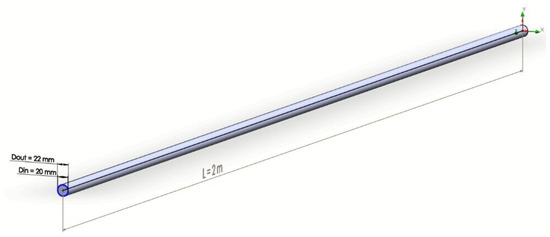
Figure 1.
The examined tube for the performed simulations.
Figure 2 shows the different examined cross-sections of the examined tube. Figure 2a shows the reference case, Figure 2b the internally fined tube with circular fines, Figure 2c the case with rectangular fins, and Figure 2d the case with triangular fins. The height of every fin was selected at 2 mm, which is a reasonable value according to the selected diameter. Totally, 8 fins were selected for every case in order to use a relatively high number of fins in order to take a suitable percentage of thermal enhancement.
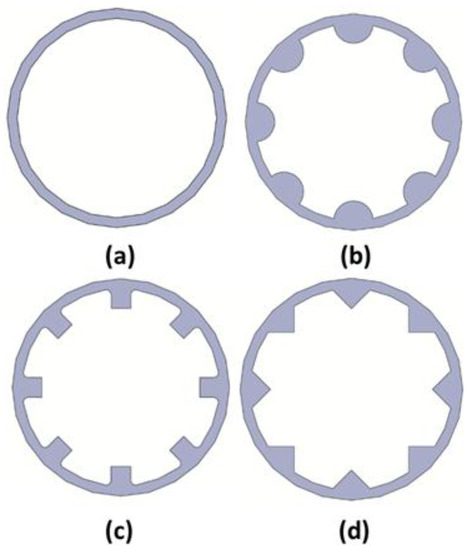
Figure 2.
The studied cross-sections of the tube: (a) reference empty tube, (b) tube with circular fins, (c) tube with rectangular fines, and (d) tube with triangular fins.
2.2. Mathematical Formulation
The working fluid is heated by the heat input from the tube and so its temperature increases to (Tout) as below:
The mean fluid temperature (Tm) can be found according to the next expression:
The transfer coefficient (h) can be found as below, by utilizing the mean wall temperature (Twall):
The Nusselt number (Nu) is connected with the (h) as below:
The friction factor of the flow (f) can be found below:
The mean fluid’s velocity (u) can be written as below:
The pumping work (Wp) is defined according to the next expression:
The Bejan criterion (Be) is a proper criterion that evaluates the entropy generation type. More specifically, it evaluates the relationship between entropy generation due to the fluid’s temperature increase (ΔST) and the entropy generation due to the fluid’s pressure drop (ΔSP). More specifically, it is defined as below [17]:
For the empty tube, accurate equations about the (Nuth) and the (fth) have been suggested by Gnielinski [18]:
where the water Prandtl number has to be used twice, one calculated for the mean fluid temperature (Prfluid) and one for the mean wall temperature (Prwall). The Reynolds number (Re) is defined as below:
2.3. Developed Model
In this work, the simulation is conducted with SolidWorks Flow Simulation [19] which is a strong design and a computational fluid dynamics (CFD) tool. The first step in this study was the design of the four different tubes, the reference one, and the three finned tubes. The next step is the development of the CFD studies by introducing the proper boundary conditions. More specifically, the boundary conditions of the developed model are the following:
- (a)
- The mass flow rate in the inlet () was set from 0.20 kg/s up to 0.35 kg/s with step 0.05 kg/s. Moreover, the flow is selected to be fully developed.
- (b)
- The inlet fluid temperature (Tin) was selected to be ranged from 290 K up to 360 K with a step of 10 K.
- (c)
- The outlet pressure was set at 4 bar.
- (d)
- The heat input in the internal surface of the tube was set at 6281 W.
The working fluid is selected to be water, and the respective thermal properties were used in the present investigation. Moreover, the tube is selected to be made of copper. The used tool solved the problem by applying the governing equations of continuity, momentum, and energy, while the k-ε turbulence model was selected [20].
During the analysis, 32 different cases were studied for every tube design (8 inlet temperatures and 4 mass flow rates) and so a total of 128 scenarios are presented. In every simulation, the most valuable outputs of the model are the outlet temperature of the fluid (Tout), the pressure drop (ΔP), and the mean wall temperature of the inner surface (Twall).
Another important step in the analysis is the selection of a suitable computational mesh. Different meshes have been examined, and Table 1 summarizes the results for 4 different meshes for the empty tube case. It is obvious that the “Mesh 4” is a reliable choice that can lead to results independent from the mesh structure. It is also useful to state that the mesh was created by SolidWorks Flow Simulation by choosing the proper setting for having a dense mesh, especially close to the surface between solid and fluid materials.

Table 1.
The examined meshes for the reference case.
2.4. Model Validation
The created model was properly validated by comparing the obtained results with the theoretical expressions for the Nusselt number and the friction factor for the reference case. More specifically, the validation process uses the equations of Gnielinski [18] which have been described in Section 2.2. More specifically, the equations of Gnielinski [18] have been used in order to determine properly the pressure drop (ΔP) and the heat transfer coefficient (h) following the described mathematical formulas in Section 2.2. These results are compared with the results of the simulation tool in order to determine the deviations and evaluate them.
Figure 3 shows the heat transfer coefficient for different values of the Reynolds number. These points correspond to the cases with different mass flow rates (from 0.20 kg/s up to 0.35 kg/s) and to different inlet temperatures (from 290 K up to 360 K). The results are given for the theoretical case and the simulation analysis. It is obvious that the respective points are close to each other for the examined range of the Reynolds number. Figure 4 shows that the deviations are relatively low and are inside the error bar of 5%. Therefore, it is obvious that the maximum error is up to 4.95%, while the mean deviation is found at 1.2% which is a low value.
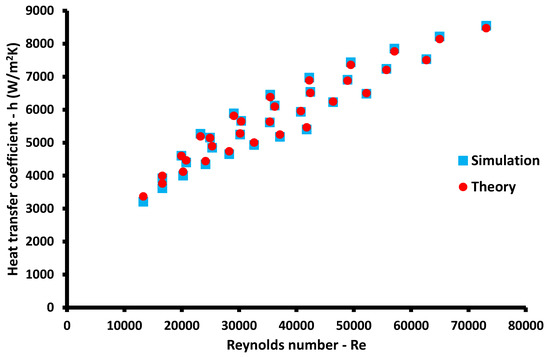
Figure 3.
Heat transfer coefficient from simulation studies and theoretical calculations.
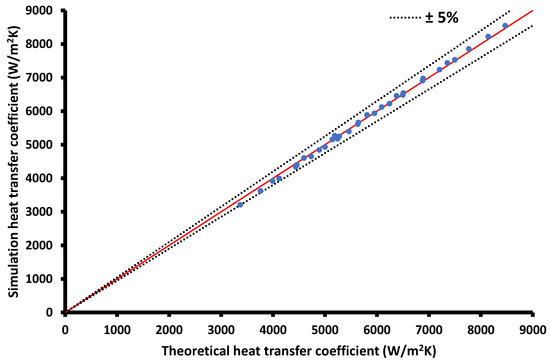
Figure 4.
Deviations in the heat transfer coefficient between simulation studies and theoretical calculations.
The next step is to check the results of the pressure drop. Figure 5 shows the pressure drop for the different investigated cases (combinations of different mass flow rate values and inlet temperature levels). It is clear that the found points between the theory and the simulation are close to each other. Figure 6 exhibits the deviations between the theory and the simulation, and it is obvious that the found deviations are lower than 5%. The mean deviation of the pressure drop is found at 2.54% which is a relatively small and acceptable value.
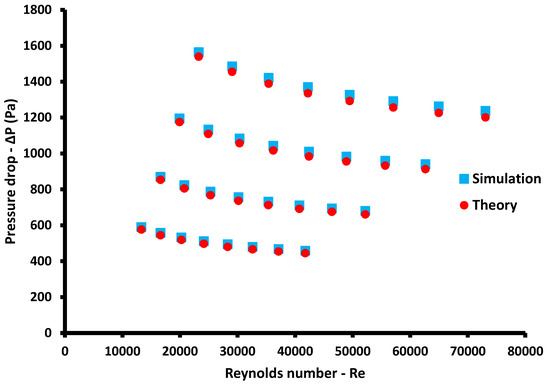
Figure 5.
The pressure drop from simulation studies and theoretical calculations.
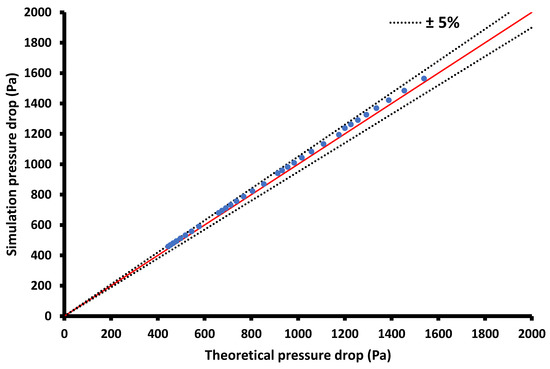
Figure 6.
Deviations in the pressure drop between simulation studies and theoretical calculations.
To conclude, the aforementioned comparison analysis makes clear that the present created model in SolidWorks Flow Simulation is able to predict with high accuracy the heat transfer coefficient and the pressure drop of the examined problem. Therefore, the results of this study can be assumed to be reliable.
3. Results and Discussion
This part includes the results obtained from the different performed simulation studies in this work. These results have been taken by simulating every design for different combinations of mass flow rate values and inlet temperature values with SolidWorks Flow Simulation.
3.1. Parametric Analysis for the Reference Case
The first part of the results section regards the presentation of the results about the reference cases which correspond to the empty tube without internal fins. The results are given for different combinations of the fluid inlet temperature from 290 K up to 360 K, and of mass flow rates from 0.20 kg/s up to 0.35 kg/s. Figure 7 shows the variation of the Nusselt number for the different examined scenarios. Higher fluid temperature and higher mass flow rate lead to higher values of the Nusselt number. The Nusselt number ranges from 112 to 251 for all the studied cases. Moreover, Figure 8 indicates that the fluid heat transfer coefficient has similar behavior to the Nusselt number. More specifically, the heat transfer coefficient increases with the increase of both inlet fluid temperature and mass flow rate. Moreover, the heat convection coefficient ranges from 3761 to 8471 W/m2K for all the studied scenarios.
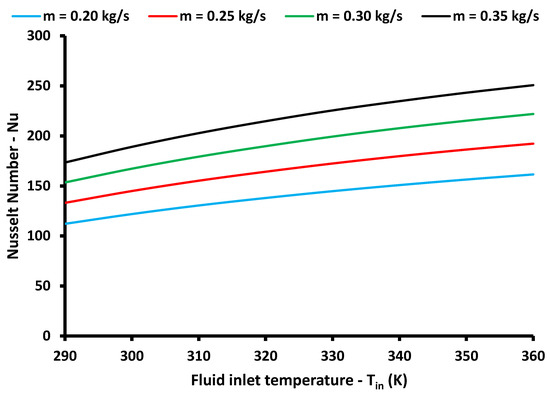
Figure 7.
Nusselt number variation for the different operating scenarios in the reference case of the empty tube.
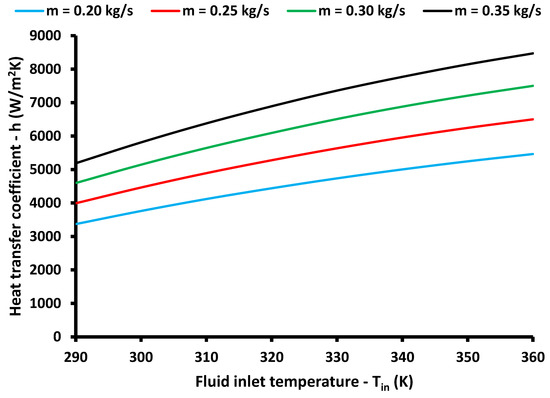
Figure 8.
Heat transfer coefficient variation for the different operating scenarios in the reference case of the empty tube.
The next part of the investigation rewards the fluid energy loss during the movements in the tube. Figure 9 shows the variation of the friction factor with the variation of the independent parameters. It is obvious that the increase in the fluid temperature and the mass flow rate leads to a lower friction factor. However, the reduction of the friction factor is not high and generally, the friction factor takes values in the range from 0.019 to 0.027. Figure 10 illustrates the pressure drop for the different cases. Interestingly, the pressure drop increases with the increase of the mass flow rate, while it reduces with the increase of the fluid temperature. It was found that the pressure drop ranges from 445 to 1455 Pa, so there is an important variation in the pressure drop among the examined cases.
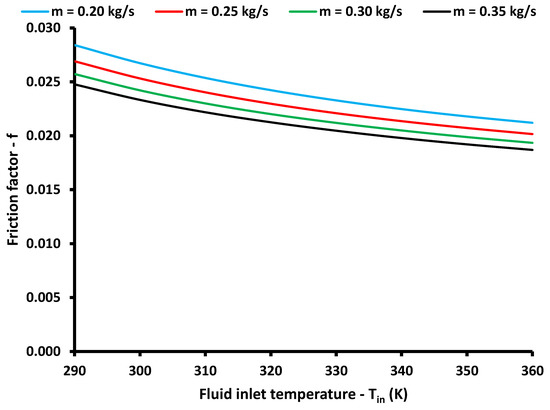
Figure 9.
Friction factor variation for the different operating scenarios in the reference case of the empty tube.
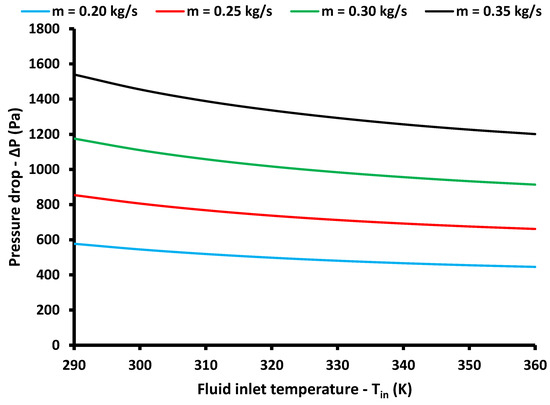
Figure 10.
Pressure drop variation for the different operating scenarios in the reference case of the empty tube.
Figure 11 depicts the pumping work demand which takes generally low values compared to the heat input of 6281 W. The pumping work ranges from 0.09 W to 0.51 W. The pumping work demand is directly associated with the pressure drop, and thus it takes lower values when the temperature increases.
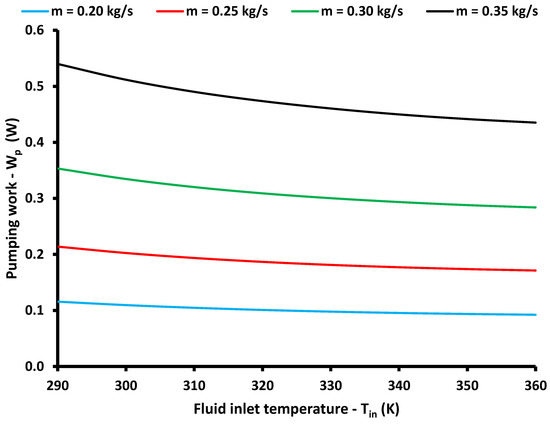
Figure 11.
Pumping work demands variation for the different operating scenarios in the reference case of the empty tube.
The Bejan number is an important index, which is depicted in Figure 12. This criterion is defined as the ratio of the generated entropy due to the fluid temperature increase to the total generated entropy. It has to be said that the total generated entropy includes the entropy generation due to both temperature increase and pressure drop. According to Figure 12, the Bejan number takes high values (over 99%), which indicates that the main reason for the entropy generation is the fluid temperature increase. Therefore, the application of thermal enhancement methods, such as the use of internal fins, is needed in order to enhance the heat transfer conditions and reduce the total entropy generation. It is notable to state that the Bejan number reduces a bit with the increase of the mass flow rate due to the higher pressure drop in these cases. Moreover, it has a very small decrease with the increase in the fluid’s temperature. This criterion is an important one in order to evaluate the impact of the pressure drop on heat transfer problems.
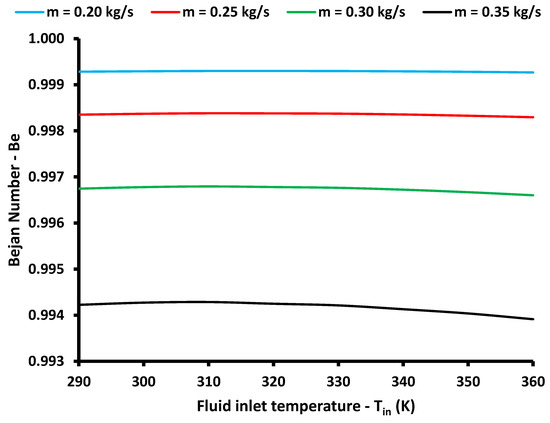
Figure 12.
Bejan number variation for the different operating scenarios in the reference case of the empty tube.
The mean wall temperature is an important parameter which is depicted in Figure 13. This temperature level increases approximately linearly with the increase of the inlet fluid temperature. Moreover, it takes higher values when the fluid moves with a lower velocity, which means a lower mass flow rate. Practically, the lower mass flow rate makes the working fluid warmer (higher temperature increase), which leads to a higher wall temperature because the wall temperature has to be always higher than the fluid temperature. It is also notable that the curves of m = 0.30 kg/s and m = 0.35 kg/s are close to each other, which indicates that a higher mass flow rate would not lead to significantly different results.
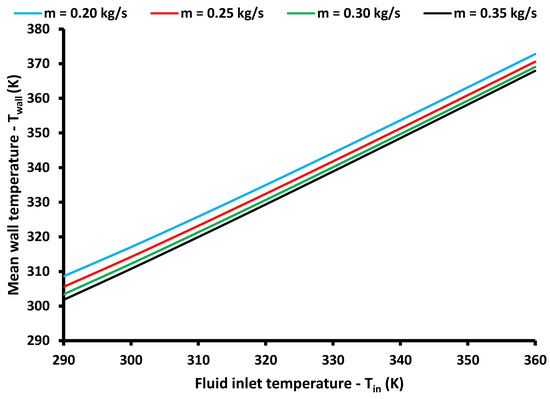
Figure 13.
Mean wall temperature variation for the different operating scenarios in the reference case of the empty tube.
3.2. Comparison of the Different Tubes
The second part of this analysis is the comparison of the different finned tubes with the reference cases. The results are presented with the Reynolds number in the horizontal axis to show the impact of the critical flow parameter (Re) on the results. Every depicted point in the following figures corresponds to a different combination of fluid inlet temperature and mass flow rate (Tin, m).
Figure 14 gives the results of the Nusselt number which is the main dimensionless number that describes the heat transfer phenomena. Moreover, the heat convection coefficient of the fluid, which is directly associated with the Nusselt number, is depicted in Figure 15. Both Figure 14 and Figure 15 indicate that the finned tubes lead to higher heat transfer rates from the tube to the fluid compared to the reference case. The use of rectangular fins seems to be the most effective design, while circular fins are the second one and triangular fins are the third one. The difference between the circular and the triangular fin cases is relatively low according to the results. Moreover, the enhancement margin seems to be higher in the cases with higher Reynolds numbers compared to the small Reynolds numbers.
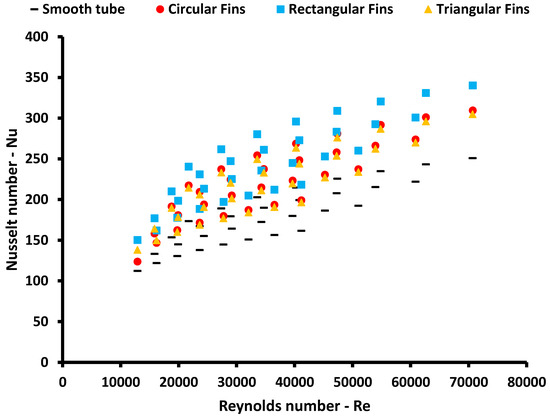
Figure 14.
Nusselt number in the examined cases for all the tubes.
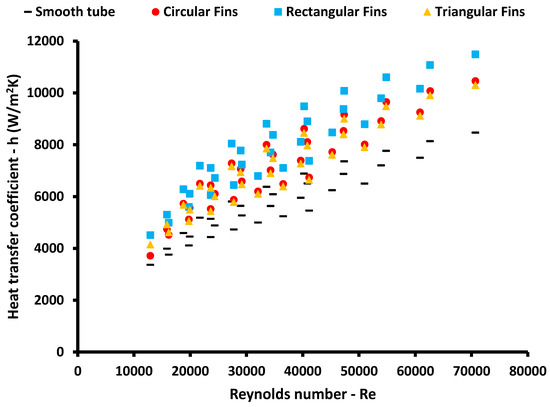
Figure 15.
Heat transfer coefficient in the examined cases for all the tubes.
The results of the friction factor are given in Figure 16, the pressure drop in Figure 17, and the pumping work demand in Figure 18. The friction factor shows clearly that the finned tubes lead to significantly higher friction losses compared to the reference case. The rectangular fins lead to the maximum friction factor with circular fins to follow with a very small difference. The triangular fins follow with a lower friction factor, while the reference empty tube has the lowest value of the friction factor. The results about the pressure drop and the pumping work demand show that the Reynolds number is not the only parameter that includes these parameters, and thus, there is a cloud of points. However, it can be said that in the respective cases, the use of fins leads to greater pressure drop and higher pumping work demand compared to the reference case. It could be said that the pumping work is about 60% higher with rectangular fins. Figure 19 depicts the results for the Bejan number which is over 99%. Therefore, the impact of the pressure drop on the system-generated entropy is not high in all cases. However, the Bejan number is lower for the finned designs compared to the reference case due to the higher pressure drop in these cases.

Figure 16.
Friction factor in the examined cases for all the tubes.
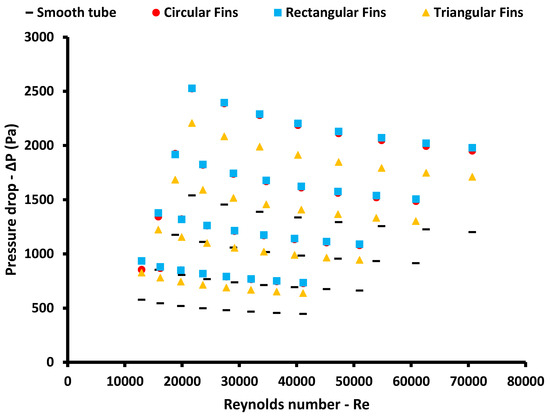
Figure 17.
Pressure drop in the examined cases for all the tubes.
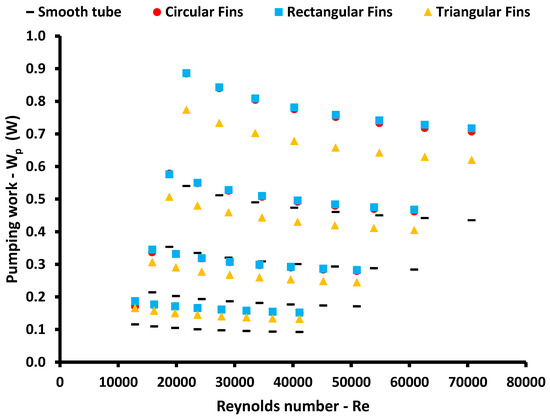
Figure 18.
Pumping work demand in the examined cases for all the tubes.
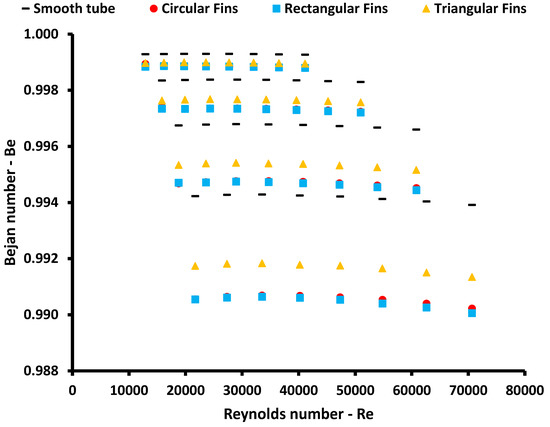
Figure 19.
Bejan number in the examined cases for all the tubes.
Figure 20 shows that the mean wall temperature of the tube is higher for the reference case compared to the finned tube. Practically, the lower heat transfer rates in the reference case leads to superheating in the tube in order to deliver the heat input in the working fluid. The finned tubes present similar wall temperature levels, with the rectangular finned tube having the lowest wall temperature level.
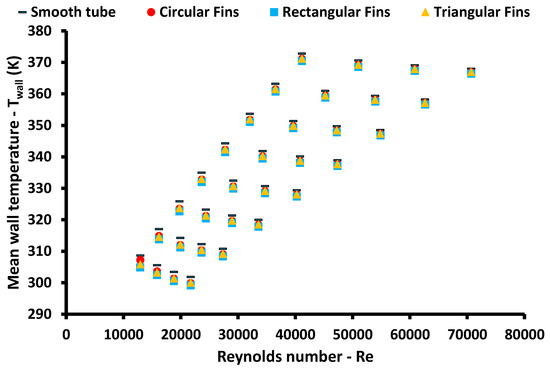
Figure 20.
Mean wall temperature in the examined cases for all the tubes.
The last step in this analysis is the presentation of some figures about the fluid temperature in the tube outlet (Figure 21) and the fluid velocity in the tube outlet (Figure 22). In every figure, the four different cases are given. It can be said that the fluid is warmer close to the tube, while it has a higher velocity in the tube center. These are reasonable and acceptable results that verify the results.
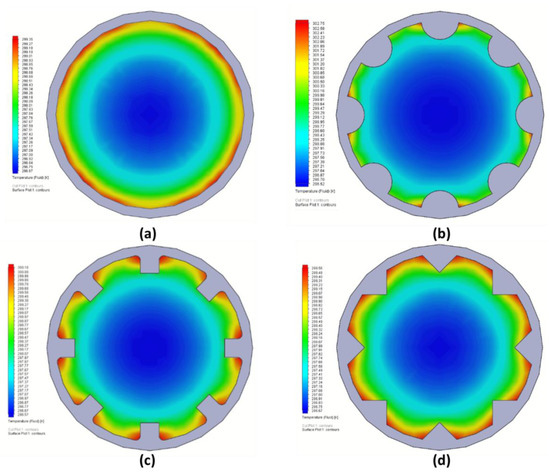
Figure 21.
The fluid temperature in the outlet cross-section for the (a) reference empty tube [296.67–299.35 K], (b) tube with circular fins [296.52–302.75 K], (c) tube with rectangular fines [296.57–300.18 K], and (d) tube with triangular fins [296.67–299.58 K].
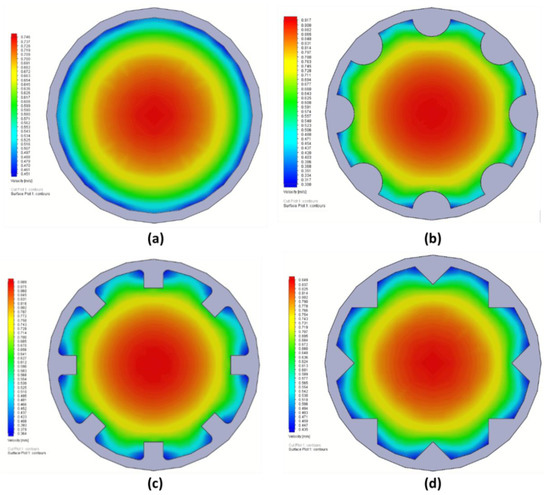
Figure 22.
Fluid velocity in the outlet cross-section for the (a) reference empty tube [0.451–0.746 m/s], (b) tube with circular fins [0.300–0.917 m/s], (c) tube with rectangular fines [0.364–0.889 m/s], and (d) tube with triangular fins [0.435–0.849 m/s].
3.3. Final Evaluation of the Different Cases
The last step in the present investigation concerns the evaluation of the Nusselt number increase with the simultaneous friction factor increase. Figure 23 shows that clearly the Nusselt number ratio (Nu/Nu0) is enhanced with the fins. The rectangular fins lead to 36% enhancement, circular fins to 25% enhancement, and triangular fins to 23% enhancement, approximately, compared to the reference tube. It is useful to state that in low Reynolds numbers, the circular tube leads to lower enhancements, which is considered an interesting result.
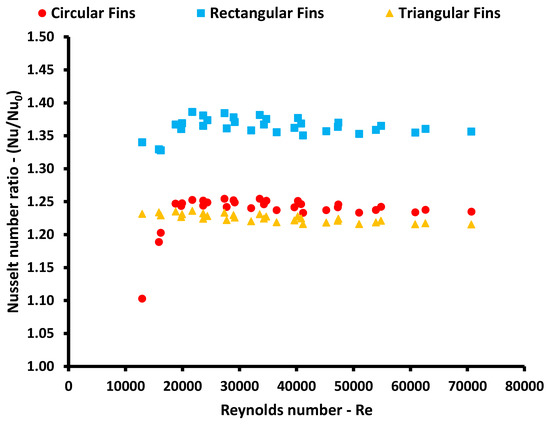
Figure 23.
Nusselt number ratio in the different examined operating conditions for the different finned tubes.
Figure 24 shows the variation of the friction factor ratio (f/f0) for the finned tubes. The rectangular and the circular fins lead to a higher friction factor increase of around 65% and 63%, respectively. The triangular fins lead to a 43% friction factor increase. Moreover, it is useful to state that in low Reynolds numbers, the circular fins lead to a lower increase in the friction factor.
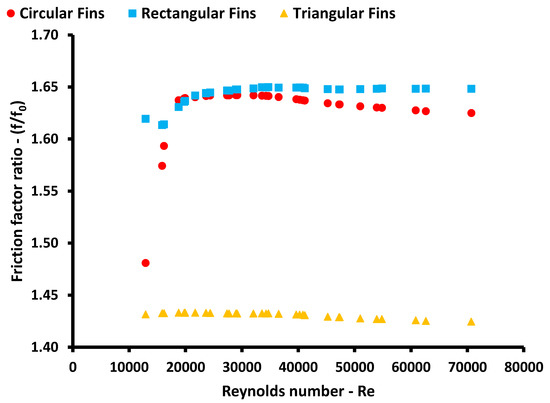
Figure 24.
Friction factor ratio in the different examined operating conditions for the different finned tubes.
The last step is the proper evaluation of the aforementioned ratios of the (Nu) of the (f). The performance evaluation criterion (PEC) is used as a proper criterion for this purpose which has been defined in Equation (1). The results of Figure 25 show that the PEC is over 1 for all the cases, so there is flow enhancement in all the examined cases with all the finned tubes. This is an important result that indicates that the idea of using internal fins works for enhancing the flow totally. More specifically, the PEC is around 1.16 for the rectangular finned tube, 1.09 for the triangular finned tube, and 1.06 for the circular finned tube. Thus, the most appropriate design is the one with rectangular fins.
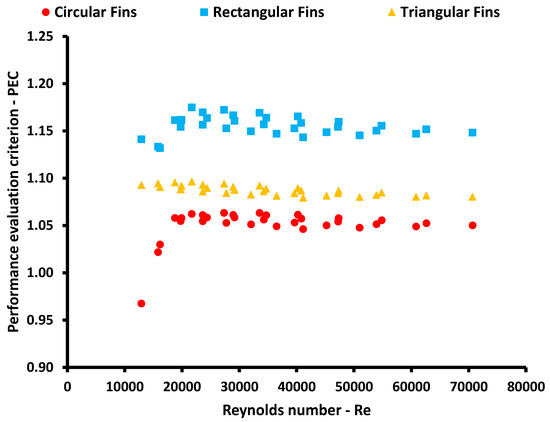
Figure 25.
Performance evaluation criterion ratio in the different examined operating conditions for the different finned tubes.
Moreover, the calculated results for the (Nu) and the (f) are presented in the following equations. These equations have been found with the proper approximations, and the mean error (Erm) is relatively low; thus, these equations are accurate. These equations can be used for water and Reynolds number in the range of 10,000 < Re < 70,000. The format of these equations follows typical formats of similar equations in the literature and so a very accurate approximation was achieved.
Reference tube:
Circular finned tube:
Rectangular finned tube:
Triangular finned tube:
Furthermore, it is useful to define the mean error (Erm) according to Equation (21). More specifically, when the approximated value is (X) and the real calculated values are (X0), while there are (N) points of approximation, the error is defined as:
In the end, it is useful to discuss the present results with other studies from the literature. The present work uses 8 internal fins, and this number is correct according to the literature. Pai and Yeh [16] found that the internal fins are the optimum choice. Moreover, the present work found that the thermal enhancements with rectangular fins are around 36%, while the results of Reference [16] indicate enhancements of around 34% for a relatively low-pressure drop, so there is an agreement with this study. Moreover, it is very interesting that applying the suggested equations for the eight rectangular straight fins of Reference [21], the heat transfer enhancement is found again at 36%. Therefore, it is clear that the results obtained in this work are reliable and acceptable.
In the future, the examined internal fins will be optimized in order to determine the optimum thickness, height, and shape. Moreover, an idea is to model the fin geometry parametrically (e.g., with a polynomial Bezier–Bernstein) and to optimize their geometry with a free-form deformation methodology. Last but not least, the number of the fins can be also examined.
4. Conclusions
The aim of this analysis is the detailed examination of the flow and heat behavior of tubes with different fins. The use of internal finds with circular, rectangular, and triangular shapes is studied and compared with the reference case of the empty tube. The analysis is carried out for different inlet fluid temperatures and different mass flow rates to study the system under different operating conditions. Below, the most critical conclusions are given:
- -
- All the examined finned tubes lead to significant improvement in the heat transfer. The rectangular fins lead to 36% enhancement, circular fins to 25% enhancement, and triangular fins to 23% enhancement, approximately, compared to the reference tube.
- -
- All the examined finned tubes lead to an increase in the pressure drop. The rectangular fins lead to a 65% increase, circular fins to a 63% increase, and triangular fins to a 43% increase, approximately, compared to the reference tube.
- -
- The performance evaluation criterion (PEC) is calculated over 1 in all the finned tubes, and thus, all the examined designs lead to significant flow enhancement. More specifically, the PEC is around 1.16 for the rectangular finned tube, 1.09 for the triangular finned tube, and 1.06 for the circular finned tube.
- -
- The most suitable design is the tube with the rectangular fins; the second one is the design with the triangular fins, while the use of circular fins is the less effective design.
- -
- The pumping work demand takes very small values, which indicates that it is not an obstacle in the system operation. Moreover, the Bejan number takes values over 99%. Τhis fact proves that the entropy is mainly generated due to the temperature increase, and the pressure drop does not generate an important amount of entropy in the system.
Author Contributions
E.B.: conceptualization, methodology, software, validation, formal analysis, investigation, writing—original draft preparation, writing—review and editing; P.L.: software, writing—original draft preparation; C.T.: writing—original draft preparation, supervision. All authors have read and agreed to the published version of the manuscript.
Funding
This research received no external funding.
Informed Consent Statement
Not applicable.
Data Availability Statement
Data available after request.
Conflicts of Interest
The authors declare no conflict of interest.
Nomenclature
| Be | Bejan number |
| cp | Specific heat capacity, J/kgK |
| Din | Inner tube diameter, m |
| Dout | Outer tube diameter, m |
| f | Friction factor |
| h | Heat convection coefficient, W/m2K |
| k | Thermal conductivity, W/mK |
| L | Tube length, m |
| M | Mass flow rate, kg/s |
| N | Points of approximation |
| Nu | Nusselt Number |
| PEC | Performance Evaluation Criterion |
| Pr | Prandtl Number |
| Q | Heat rate, W |
| q | Heat flux, W/m2 |
| Re | Reynolds Number |
| Tin | Fluid inlet bulk temperature, K |
| Tm | Fluid mean temperature, K |
| Tout | Fluid outlet bulk temperature, K |
| Twall | Mean wall temperature, K |
| u | Mean fluid velocity, m/s |
| Wp | Pumping work demand, W |
| X | Parameter of approximation |
| Greek Symbols | |
| ΔP | Pressure drop, Pa |
| ΔSP | Generated entropy due to pressure drop, W/K |
| ΔST | Generated entropy due to temperature increase, W/K |
| μ | Dynamic viscosity, Pa s |
| ρ | Density, kg/m3 |
| Subscripts and Superscripts | |
| circ | Circular fins |
| fluid | Mean fluid |
| rect | Rectangular fins |
| ref | Reference tube |
| th | Theoretical |
| tri | Triangular tube |
| wall | Mean wall |
| 0 | Reference case |
References
- The 17 Goals. Department of Economic and Social Affairs, Sustainable Development, United Nations. Available online: https://sdgs.un.org/goals (accessed on 1 February 2022).
- Yang, X.; Chen, P. Heat transfer enhancement strategies for eco-friendly dry hobbing considering the heat exchange capacity of chips. Case Stud. Therm. Eng. 2021, 29, 101716. [Google Scholar] [CrossRef]
- Mahian, O.; Bellos, E.; Markides, C.N.; Taylor, R.A.; Alagumalai, A.; Yang, L.; Qin, C.; Lee, B.J.; Ahmadi, G.; Safaei, M.R.; et al. Recent advances in using nanofluids in renewable energy systems and the environmental implications of their uptake. Nano Energy 2021, 86, 106069. [Google Scholar] [CrossRef]
- Akbarzadeh, S.; Valipour, M.S. Heat transfer enhancement in parabolic trough collectors: A comprehensive review. Renew. Sustain. Energy Rev. 2018, 92, 198–218. [Google Scholar] [CrossRef]
- Bellos, E.; Tzivanidis, C.; Tsimpoukis, D. Enhancing the performance of parabolic trough collectors using nanofluids and turbulators. Renew. Sustain. Energy Rev. 2018, 91, 358–375. [Google Scholar] [CrossRef]
- Said, Z.; Sundar, L.S.; Tiwari, A.K.; Ali, H.M.; Sheikholeslami, M.; Bellos, E.; Babar, H. Recent advances on the fundamental physical phenomena behind stability, dynamic motion, thermophysical properties, heat transport, applications, and challenges of nanofluids. Phys. Rep. 2021, 946, 1–94. [Google Scholar] [CrossRef]
- Hasanpour, A.; Farhadi, M.; Sedighi, K. A review study on twisted tape inserts on turbulent flow heat exchangers: The overall enhancement ratio criteria. Int. Commun. Heat Mass Transf. 2014, 55, 53–62. [Google Scholar] [CrossRef]
- Kumar, A.; Chamoli, S.; Kumar, M. Experimental investigation on thermal performance and fluid flow characteristics in heat exchanger tube with solid hollow circular disk inserts. Appl. Therm. Eng. 2016, 100, 227–236. [Google Scholar] [CrossRef]
- Eiamsa-Ard, S.; Promvonge, P. Experimental investigation of heat transfer and friction characteristics in a circular tube fitted with V-nozzle turbulators. Int. Commun. Heat Mass Transf. 2006, 33, 591–600. [Google Scholar] [CrossRef]
- Promvonge, P. Thermal performance in circular tube fitted with coiled square wires. Energy Convers. Manag. 2008, 49, 980–987. [Google Scholar] [CrossRef]
- Eiamsa-Ard, S.; Wongcharee, K.; Eiamsa-Ard, P.; Thianpong, C. Heat transfer enhancement in a tube using delta-winglet twisted tape inserts. Appl. Therm. Eng. 2010, 30, 310–318. [Google Scholar] [CrossRef]
- Fan, A.; Deng, J.; Nakayama, A.; Liu, W. Parametric study on turbulent heat transfer and flow characteristics in a circular tube fitted with louvered strip inserts. Int. J. Heat Mass Transf. 2012, 55, 5205–5213. [Google Scholar] [CrossRef]
- Bhuiya, M.; Chowdhury, M.; Ahamed, J.; Khan, M.; Sarkar, M.; Kalam, M.; Masjuki, H.; Shahabuddin, M. Heat transfer performance for turbulent flow through a tube using double helical tape inserts. Int. Commun. Heat Mass Transf. 2012, 39, 818–825. [Google Scholar] [CrossRef]
- Zhang, X.; Liu, Z.; Liu, W. Numerical studies on heat transfer and flow characteristics for laminar flow in a tube with multiple regularly spaced twisted tapes. Int. J. Therm. Sci. 2012, 58, 157–167. [Google Scholar] [CrossRef]
- Liu, L.; Cao, Z.; Shen, T.; Zhang, L. Experimental and numerical investigation on flow and heat transfer characteristics of a multi-waves internally spiral finned tube. Int. J. Heat Mass Transf. 2021, 172, 121104. [Google Scholar] [CrossRef]
- Pai, Y.-W.; Yeh, R.-H. Experimental investigation of heat transfer and pressure drop characteristics of internal finned tubes. Int. J. Heat Mass Transf. 2021, 183, 122183. [Google Scholar] [CrossRef]
- Bejan, A. Advanced Engineering Thermodynamics, 3rd ed.; John Wiley & Sons Inc.: Hoboken, NJ, USA, 2006. [Google Scholar]
- Gnielinski, V. New Equations for Heat and Mass Transfer in Turbulent Pipe and Channel Flow. Int. Chem. Eng. 1976, 16, 359–363. [Google Scholar]
- Dassault Systèmes SolidWorks Corporation. SolidWorks Flow Simulation. Available online: https://www.solidworks.com/product/solidworks-flow-simulation (accessed on 1 February 2022).
- Mwesigye, A.; Bello-Ochende, T.; Meyer, J.P. Heat transfer and thermodynamic performance of a parabolic trough receiver with centrally placed perforated plate inserts. Appl. Energy 2014, 136, 989–1003. [Google Scholar] [CrossRef] [Green Version]
- Jensen, M.K.; Vlakancic, A. Technical Note Experimental investigation of turbulent heat transfer and fluid flow in internally finned tubes. Int. J. Heat Mass Transf. 1999, 42, 1343–1351. [Google Scholar] [CrossRef]
Publisher’s Note: MDPI stays neutral with regard to jurisdictional claims in published maps and institutional affiliations. |
© 2022 by the authors. Licensee MDPI, Basel, Switzerland. This article is an open access article distributed under the terms and conditions of the Creative Commons Attribution (CC BY) license (https://creativecommons.org/licenses/by/4.0/).